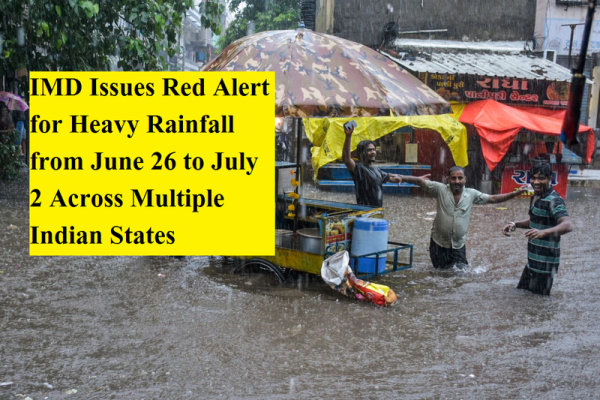IMD Issues Red Alert for Heavy Rainfall from June 26 to July 2 Across Multiple Indian States

IMD Issues Red Alert for Heavy Rainfall from June 26 to July 2 Across Multiple Indian States
India Braces for Torrential Rain: IMD Predicts Heavy to Extremely Heavy Rainfall in 20+ States, Red Alert Issued
The India Meteorological Department (IMD) has sounded a high alert across large parts of the country, forecasting widespread and intense rainfall from June 26 to July 2, 2025. A Red Alert has been issued in several districts, particularly in Kerala, Gujarat, Odisha, and parts of North and Central India, indicating a risk of extremely heavy rainfall, flooding, and strong winds.
With monsoon activity gaining momentum, citizens in several states are urged to remain alert and follow official advisories to ensure safety during this critical weather period.
Key Highlights of IMD's Rainfall Forecast (June 26–July 2):
🔴 Red Alert Zones
- Kerala: Districts like Ernakulam, Idukki, and Thrissur have already started experiencing heavy rains, with low-lying areas getting waterlogged.
- IMD has issued a red alert for Idukki, Malappuram, and Wayanad, indicating rainfall over 20 cm within 24 hours.
- Gujarat and Odisha: Expected to witness extremely heavy rainfall at isolated places throughout the week.
States Likely to Experience Heavy to Very Heavy Rainfall:
🌧️ North and Northwest India
- Punjab, Haryana, Himachal Pradesh, Uttarakhand, Eastern and Western Rajasthan, Delhi, and Chandigarh: Anticipated to receive intense rainfall with isolated spells of thunderstorms.
- Jammu & Kashmir, Ladakh, Gilgit-Baltistan, and Muzaffarabad are also on IMD's radar for heavy rainfall during this period.
- Winds are expected to gust between 30–40 km/h in these regions.
🌧️ Central India
- Madhya Pradesh, Chhattisgarh, Vidarbha, and parts of Maharashtra (especially the ghats of Madhya Maharashtra) are likely to see continuous heavy downpours.
- The Konkan coast, including Mumbai and Goa, could experience very heavy rainfall across several days.
🌧️ Eastern India
- Bihar, Jharkhand, Odisha, West Bengal (including Gangetic plains): Rainfall could be relentless, with chances of localized flooding and waterlogging in urban areas.
- The IMD warns of sustained heavy rain that may impact transportation and daily life.
🌧️ Northeastern States
- Assam, Meghalaya, Arunachal Pradesh, Nagaland, Manipur, Mizoram, and Tripura: Predicted to face very heavy rainfall accompanied by thunderstorms.
- 30 June could bring exceptionally heavy rainfall to Arunachal Pradesh.
Kerala Already Feeling the Impact
The southwest monsoon has picked up pace in Kerala, where torrential rain and strong winds have caused disruptions:
- Waterlogging in urban and low-lying areas.
- Fallen trees and damaged hoardings in Thiruvananthapuram and nearby regions.
- The state's irrigation department has also issued flood warnings due to rising river levels.
East Rajasthan Hit by Thunderstorms
Over the past 24 hours, parts of Eastern Rajasthan, including Bhungra, Danpur, Masuda, and Jhadol, received up to 115 mm of rainfall. IMD forecasts that June 26–28 will continue to bring moderate to heavy showers in the area.
Weather Outlook for Specific Periods
- June 26–28:
- Eastern Rajasthan, Uttarakhand – Heavy rainfall expected.
- June 29–July 2:
- Himachal Pradesh, Haryana, Uttar Pradesh – Thunderstorms and moderate to heavy rainfall likely.
- Uttar Pradesh will see scattered showers and thunderstorms from June 29 onwards.
IMD's Advisory for Citizens
- Avoid unnecessary travel, especially in red and orange alert zones.
- Stay indoors during lightning or strong winds.
- Watch out for landslides in hilly terrains like Uttarakhand, Himachal, and Northeast India.
- Ensure proper drainage around homes and commercial establishments to prevent waterlogging.
With the monsoon season entering a high-activity phase, the IMD’s week-long forecast signals potential hazards due to excessive rainfall. From Kerala to Kashmir, and Gujarat to Northeast India, people are advised to remain vigilant, especially in Red and Orange alert zones. As climate patterns grow more unpredictable, timely preparation and awareness can minimize disruption and damage.
